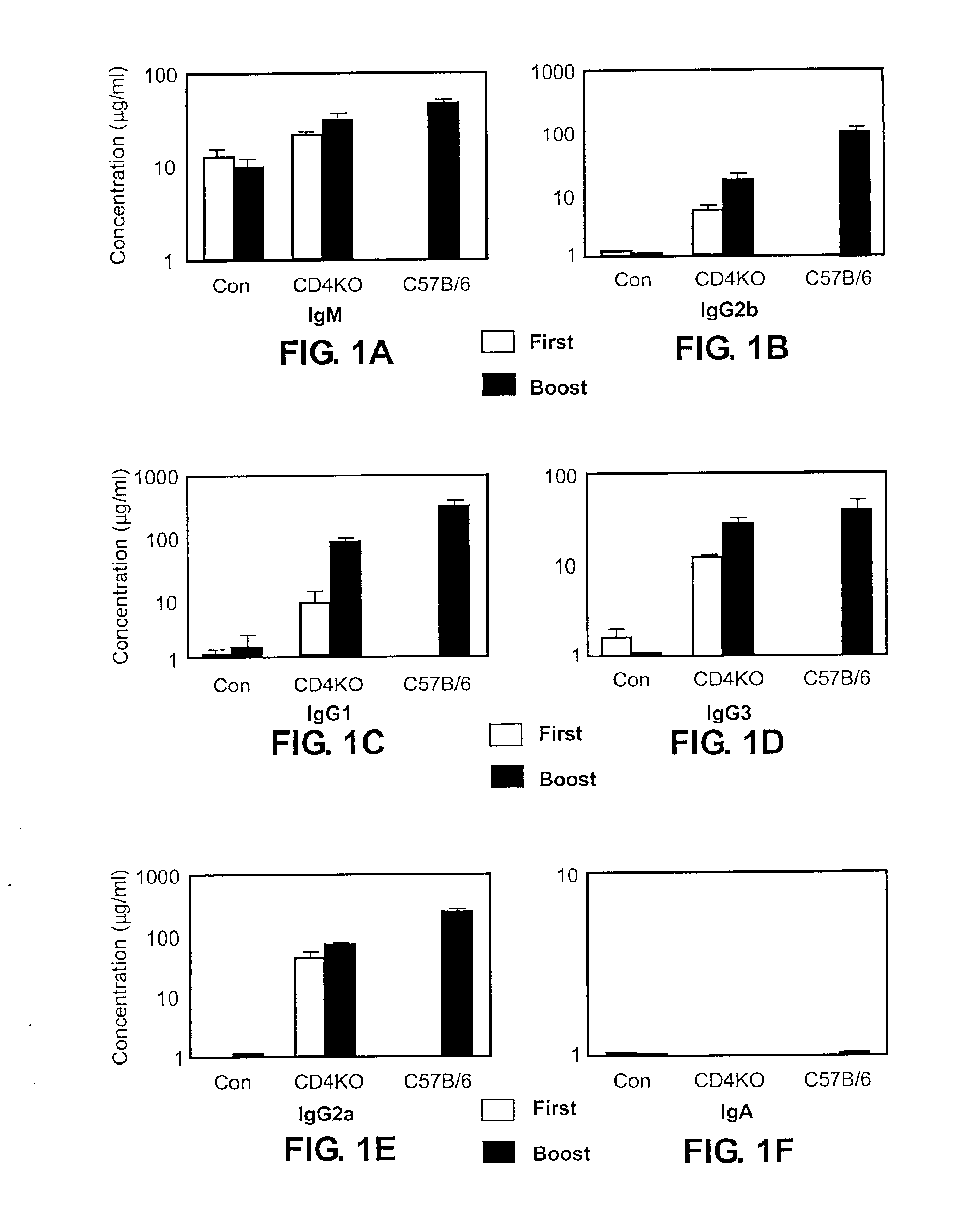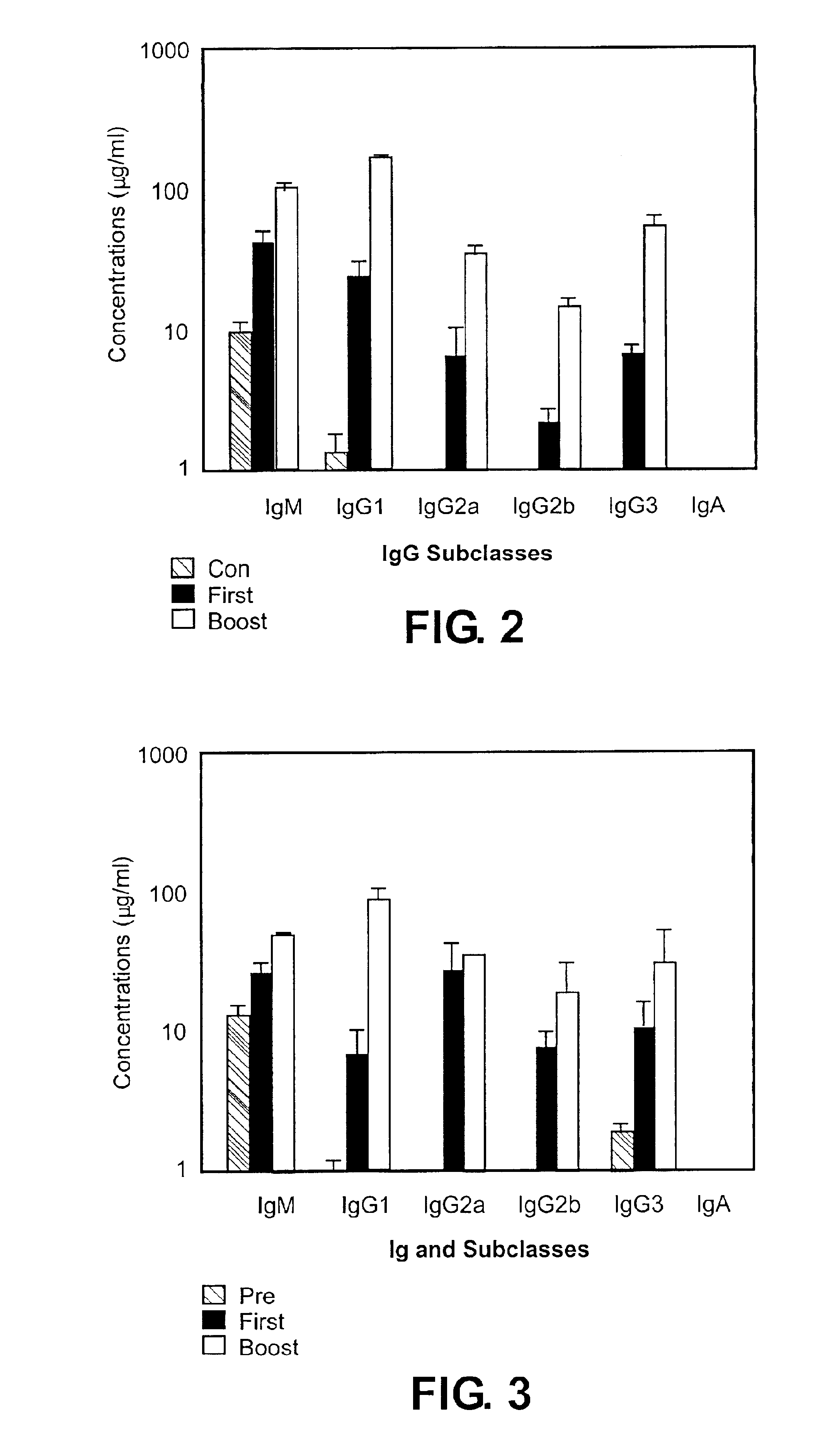Induction of immunoglobulin class switching by inactivated viral vaccine
a technology of inactivated viral vaccine and immunoglobulin, applied in the field of immunology, can solve the problems of restricted isotype pattern, low antibody titer, and virulence of inducible viruses, and achieve the effect of shortening the tim
- Summary
- Abstract
- Description
- Claims
- Application Information
AI Technical Summary
Benefits of technology
Problems solved by technology
Method used
Image
Examples
example 1
Animals
C57BL / 6J mice, C57BL / 6-Cd4tm / Mak, which had a targeted disruption in their CD4 gene and therefore lacked functional CD4+ T cells (Rahemtulla, et al. (1991) Nature 353:180), C57BL / 6J-Tcratm / Mom, which had a targeted disruption in their TCRα gene and lacked functional αβ T cells (Mombaerts et al. (1992) published erratum appears in Nature Dec. 3, 1992 360(6403):492. Nature 360:225) were obtained from the Jackson Laboratories (Bar Harbor, Me.). Some of the mice were bred in the Department of Animal Resources in Emory University from the breeding pairs purchased. Two age groups of mice were used in this study; one age group was 16-20 weeks old, the other age group was 6 weeks old.
example 2
Viruses and Immunization and Sampling
Influenza virus strain A / PR / 8 / 34 was grown in the allantoic cavity of 9-11 day old embryonated hen's eggs, and virus was purified from allantoic fluid by sucrose gradient centrifugation at 100,000×g. For inactivation, purified virus was mixed with formalin at a final concentration at 1:4000 (v / v) and incubated at 37° C. for 72 hours and then dialyzed against PBS with 3 changes. The virus stock was stored in aliquots at −80° C. before use. Inactivation of the virus was confirmed by both plaque assay on confluent monolayer MDCK cells and inoculation of the virus into 9-11 days old embryonated hen's eggs. For immunization, mice were immunized with 10 μg / 100 μl of virus protein intramuscularly (i.m.) or intraperitoneally (i.p.) at day 0 and day 15. Blood samples were collected 15 days after priming and 10 days after boosting.
Anesthetized mice were bled from retroorbital veins to obtain blood samples. Samples were centrifuged at 14,000 rpm, and sera ...
example 3
In vitro Virus Neutralization Assay
A standard plaque reduction assay was performed to determine the PR8 virus-specific neutralizing titer of the sera as previously described (Sha et al. (1999) Immunobiology 200:21). 80-120 PFU of influenza A / PR8 virus was mixed with a sera at 50, 200, 1000 and 5000-fold dilutions and incubated at room temperature for 1 hour. Aliquots of 200 μl were added onto confluent MDCK cell monolayers in 6 well plates and incubated at 37° C. for 1 hour, and the plates were shaken gently every 15 minutes. After washing, 1.95% white agar in 1×DMEM medium containing 1 μg trypsin was overlaid on the wells. After incubation at 37° C. for 4 days, plates were stained with neutral red agar. The numbers of the plaques in each well were counted. The neutralizing antibody titer is the highest dilution of the serum that was found to reduce the number of the plaques by at least 50%.
PUM
| Property | Measurement | Unit |
|---|---|---|
| molecular weight | aaaaa | aaaaa |
| concentration | aaaaa | aaaaa |
| time | aaaaa | aaaaa |
Abstract
Description
Claims
Application Information
 Login to View More
Login to View More - R&D
- Intellectual Property
- Life Sciences
- Materials
- Tech Scout
- Unparalleled Data Quality
- Higher Quality Content
- 60% Fewer Hallucinations
Browse by: Latest US Patents, China's latest patents, Technical Efficacy Thesaurus, Application Domain, Technology Topic, Popular Technical Reports.
© 2025 PatSnap. All rights reserved.Legal|Privacy policy|Modern Slavery Act Transparency Statement|Sitemap|About US| Contact US: help@patsnap.com



